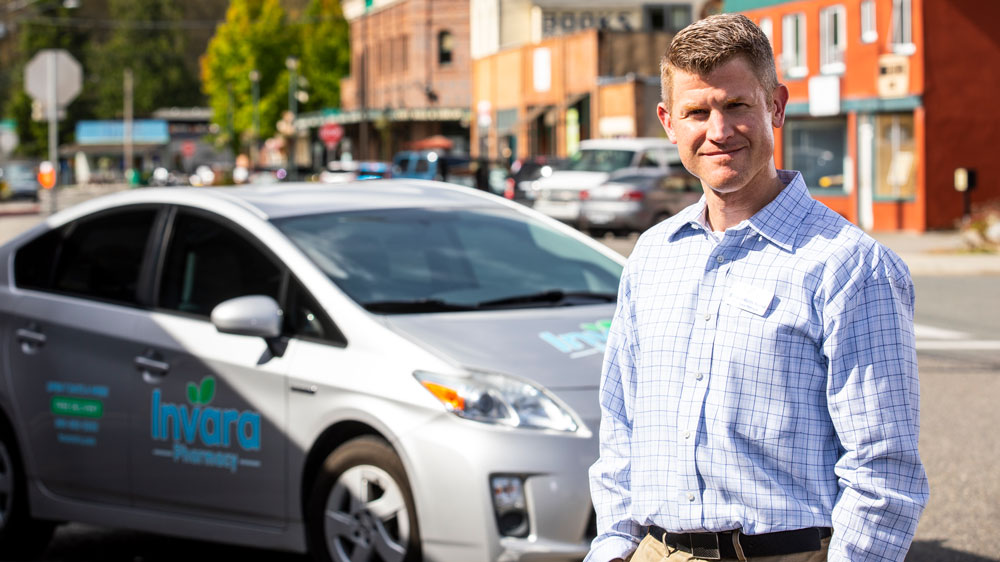
Alumnus Simeon Roth, ’17, opens a new rural pharmacy based on a business plan he worked on as a student in pharmacy school. Today, his pharmacy is providing much needed services to rural communities with little access to health care.
Nancy Kildahl is allergic to everything that isn’t nailed down.
“And I’m allergic to the nails,” the 82-year-old Sultan woman said.
She has to carefully monitor her medications and use special skin creams to avoid a reaction. Plus, she’s battling chronic obstructive pulmonary disease, COPD, and has thyroid issues. She stopped driving at 80. To get her medications, she used to rely on relatives and friends to shop for her in Monroe, about 20 minutes west on Highway 2.
Not anymore.
In July, University of Washington School of Pharmacy alumnus Simeon Roth opened Invara, a new kind of pharmacy based on a business plan he wrote while at UW. A big feature of the new store: delivery.
“I’m really, really, extremely grateful for this,” Kildahl said the other day after receiving her latest hand-delivered bag of medicines. “For me, it’s a lifesaver. Really.”
The idea for opening an innovative rural pharmacy germinated in the hallways of the UW about six years ago. In the meantime, the UW School of Pharmacy has been involved in working with state lawmakers to change public policy to allow pharmacists like Roth to do much more than dispense pills.
For Roth, the pharmacy is an incubator for an entrepreneurial concept he’s long been brewing.
“There’s no pharmacy east of here until you get to Leavenworth,” some 70 miles up the road, Roth says. Along the way there are thousands of patients like Kildahl who are homebound due to illness or injury. And Washington state has a shortage of healthcare providers, Roth points out. The national average is a ratio of 1 provider per 1,000 people. In Washington, the ratio is closer to 1:1,100. In Snohomish County, it’s almost double the national average: 1:1,900. Roth believes the ratio is closer to 1:3,000 along the Skykomish Valley where he’s opened shop.
At a time when health care companies are avoiding rural communities, Roth is going the opposite direction.
“We’re running into the mess,” the 45-year-old says.
The pharmacy profession overall is having to reinvent itself, said Don Downing, a clinical professor in the School of Pharmacy and the endowed chair of the Institute for Innovative Pharmacy Practice. Roth studied under Downing.
All the revenue has gone from filling prescriptions, Downing said. In fact, 70 % of pharmacies lose money on the prescription side of the business.
“If we’re going to remain relevant and important to a community we have to find another way,” to operate an enterprise, Downing said.
That means starting with two givens: #1. Students, like Roth, need to understand both the clinical and the business side of the pharmacy industry. (“You can’t do one without the other,” Downing said.) And #2. Change health policy in Olympia to allow pharmacists to not only survive, but take better care of patients.
Under the traditional community pharmacy model, pharmacist revenue is tied directly to filling prescriptions. That dependence on prescription sales has contributed to major problems in this country, Downing said. Think of the opioid crisis or the crammed shelves of a grandparent’s medicine cabinet.
“We have historically not been paid for our highly trained and skilled pharmacists actually making sure people are on the best therapies,” he said. “Similar to other health care providers, we need to compensate pharmacists for their health care services, including active collaboration with medical providers to help people get off of inappropriate medicines and not just pay pharmacists to fill more and more medications.”
That’s what Downing and his students from UW have done in Washington state. They worked with the Insurance Commissioner, the State Attorney General and eventually with legislators to align health policy with better patient outcomes rather than sticking with the traditional prescriptions sales only model. Now, pharmacists can be reimbursed for providing wellness care and a variety of clinical services. That’s important because pharmacists like Roth often are plugged into the day-to-day lives of their patients.
“We have the biggest point of contact with patients,” Roth said. “Nobody has more contact in the health care industry than pharmacists.”
What often happens, Roth said, is that patients with complex chronic conditions — think high blood pressure or diabetes or smoking — don’t see their doctors that frequently. They’re often sent back to the community with little education about how to manage their disease. That can lead to several problems, including having trouble with medications.
Clinicians aren’t plugged into the daily lives of patients like a community pharmacist is. So Roth is working on changing the dynamic. He wants to partner with health care providers, doctors and hospitals to take care management — no just filling prescriptions, but providing a continuation of the chain of care to the patient.
“We’re bridging the gap,” Roth said.
As Invara matures Roth hopes to vastly expand the services he offers. In addition to being open seven days a week and offering free next-day delivery, Roth wants to offer patient education, durable medical equipment such as wheelchairs, plus immunizations and vaccinations, and clinical care for common ailments like infections and the flu.
“There’s hundreds or thousands of more people that we can continue to help and really change their lives not only medically but just in the grand scheme of things,” Roth said. “We’re working on just trying to make the world a better place.”